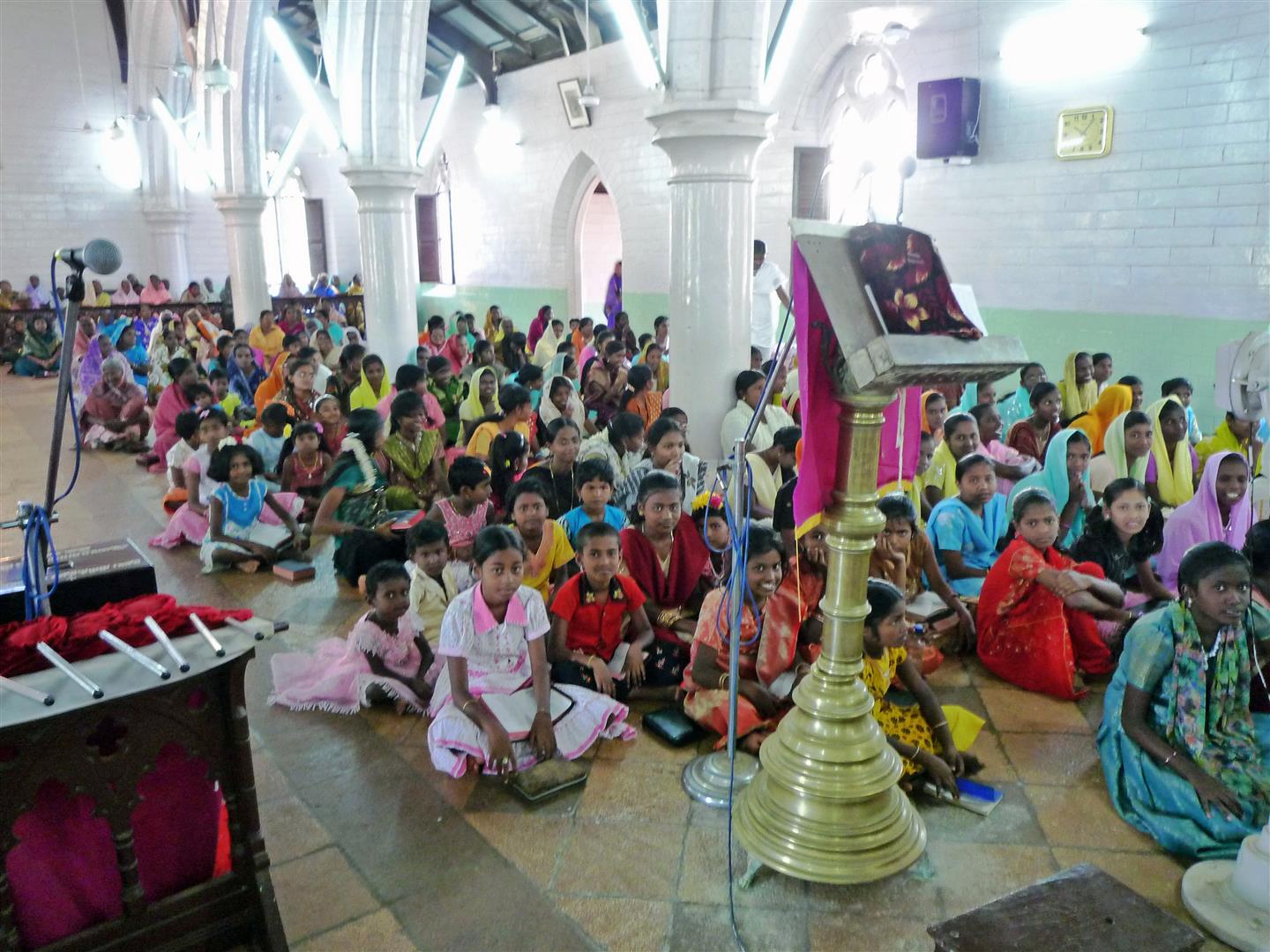You may use these images without prior permission for any scholarly or educational purpose as long as you (1) credit the photographer and (2) link your document to this URL in a web document or cite the Victorian Web in a print one. [Click on the images for larger pictures.]

Holy Trinity Church, Idaiyangudi, Tinnevuly (now, Tirunelveli). Robert Caldwell (1814-1891). This took thirty-three years to build, the foundation stone having been laid in 1847, and the consecration taking place in 1880 (see Gore 155). It is a huge building, with space for a congregation of 3000, and David Gore adds that:
the consecration was attended by nearly 9,000 natives of whom 7,000 were Christians and nearly 2000 Hindus. That there were 35 native clergymen present reflected the efforts Caldwell had made towards the indigenous future of the church. Robert and Eliza Caldwell [his wife] are now both buried beneath the chancel of Holy Trinity. [155]

Local children gathered in the interior of the church.
An information board outside the church (photographed on Wikipedia) tells us exactly how large this Gothic Revival church is. It
measures 85 feet length and 52 feet breadth with 35 feet altar and 66 feet tower. The window panes, the portals, the curves, the holy table and the white pillars in the church were designed in small models in clay by the Bishop himself and the workers carved each part to shape in black stone. The exquisite and embellished window in the altar was constructed with the donation of Rs. 500/-, offered by the Honourable Governor Napier. The location of the main portal of the church at the south end, instead of being in the centre, is a very special feature of this church. There is a minimum sized spiral staircase, built with black stones which go up to the first floor of the steeple.

Statue of Robert Caldwell erected on the Marina at Chennai in 1967.
As for Caldwell himself, he later became a bishop. His influence continued in two ways. Patrick Carson writes to tell us that his descendants set up a trust, “The Robert & Eliza Caldwell Trust,” in the early 2000s, and that the Church, school, orphanage and nurses' college which benefit from it are all thriving, with around three hundred students in the nurses' college now: it has "expanded into newly built premises." He adds, "the bishop's legacy is in good shape." In addition to his missionary work, Caldwell contributed greatly to the scholarship of South India, publishing a Comparative Grammar of the Dravidian, or South Indian Family of Languages in 1856. The work was highly influential in his own time and is still in print. Robert Frykenberg says that it "remains a standard authority" and points out that Caldwell was "the first to argue that south India's four main languages — Tamil, Telugu, Kannada, and Malayalam — had 'a common origin' and were 'a separate family,' altogether distinct from the Aryan family of languages." His theory would encourage the movement called the Tamil Renaissance, which had important political and social consequences far beyond Idaiyangudi. He is still honoured now for his dedication to the Tamils: his bicentenary was observed with all due solemnity in 2014, and his statue garlanded (see Kolappan).
Some Other Anglican Churches in S. India
- Holy Trinity Cathedral, Kottayam
- All Saints, Coonor, Tamil Nadu
- Christ Church, Trivandrum (Thiruvananthapuram)
- St Mary’s, Madras (Chennai)
Related Material
Bibliography
Frykenberg, Robert Eric. "Caldwell, Robert (1814–1891), missionary and orientalist." Oxford Dictionary of National Biography. Online ed. Web. 10 September 2020.
Gore, David. "Faith and Family in South India." The British Empire (large site with many contributors, run by Stephen Luscombe). Web. 10 September 2020.
_____. Soldiers, Saints and Scallywags: Stirring Tales from Family History. Newbury, Berks.: David Gore, 2009. Full view on Google Books. Web. 10 September 2020.
Information board photographed by Sajeevjino and posted on Wikipedia. Web. 10 September 2020.
Kolappan, B. "Caldwell bicentenary to spotlight his contribution to Tamil." The Hindu, 6 May 2014. Web. 10 September 2020.
Last modified 21 September 2020